|
1.
CENTRAL/ WEST AFRICA
Fourth quarter situation
The start of the fourth quarter brings no change in the
market situation. Trade to Asian destinations still
dominates the West African export business with some
steady orders for sawn lumber shipped into the Middle
East and North Africa, though at very competitive prices.
Italian buyers also remain the most active in the EU
according to shippers. As was the situation at the time of
the last report, price negotiations are very tough and
buyers are demanding competitive pricing.
Azobe logs are being sold into China as the demand from
European buyers is now very slack and usually calls for
certified timber that is more difficult to source and of less
interest to exporters, at least for the time being.
Demand for Andoung has fallen away and prices are
trending downwards and weaker.
Weak sawnwood demand
Sawnwood demand in European markets is weak and this
situation has persisted over the past few months. There are
some ¡®hints¡¯ of possible increases in business with South
Africa but this has not yet turned into firm orders.
There is said to be more interest in sawn Okoum¨¦ for
China but this business is developing very slowly. West
African exporters seem to have given up on the hoped for
autumn/winter surge in orders from the UK or wider EU,
in-fact, even enquiries are few.
There is a trickle of business for sawnwood but exporters
continue to concentrate on the steady demand for logs into
China and India, while actively looking at alternative
markets for the available limited volumes of sawn and
processed products.
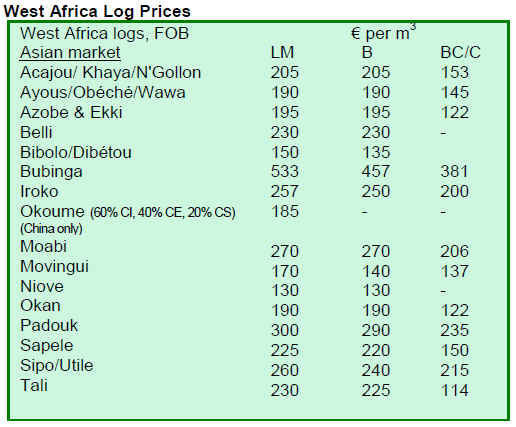
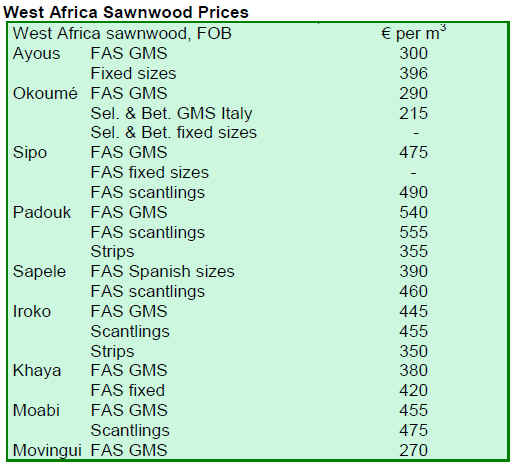
2. GHANA
Volta lake timber resources
Ghana is set to benefit from underwater logging in the
Volta Lake, this is expected to begin in September 2010. It
is estimated that timber resources worth nearly US$3
billion are submerged in the lake.
A partnership has apparently been signed between Clarke
Sustainable Resources Developments (CRSD) and Triton
Logging to implement the commercial phase of the Volta
Lake Timber Project. Now the deal has been sealed, Triton
will deliver its underwater logging technology to the
project, thus paving the way for commercial operations to
begin.
The Volta Lake was created with the construction of the
Akosombo Dam in 1964, resulting in the submergence of
vast areas of forest. In February 2006, the Volta River
Authority and Government of Ghana signed an agreement
for phase 1 on harvesting, processing and marketing of
timber from the Volta Lake with CSRD.
The agreement was ratified by Parliament in 2006
allowing CSRD to plan the timber salvage and processing
operations on the Volta Lake. An underwater stock survey
and inventory of commercial tree species in the lake and
an environmental and social impact assessment study will
be conducted before commercial operations commence.
The project plans to deliver certified timber products from
Ghana to the global market so to establish Ghana as a
world leader in underwater timber harvesting. The project
will also develop technologically advanced processing and
value-added capacity in the country.
An additional benefit from this project will be safer lake
transportation as the submerged trees are removed. There
have been fatal boat accidents caused by submerged trees.
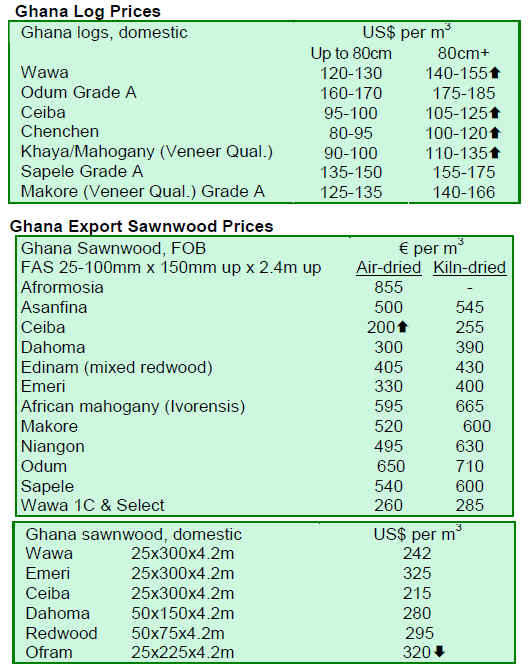
3.
MALAYSIA
No new logging
The government of the most industrialised State in
Peninsular Malaysia, Selangor, has stopped issuing
licenses for logging on all state land. The State
government met in July this year and issued a ban on
logging on all State land with immediate effect. However,
the ban on logging in mangrove forests will only take
effect at the end of the year.
The Malaysian Federal Constitution mandates that land
and natural resources are matters under the jurisdiction of
the State governments. Logging licenses currently held by
concessionaires will not be renewed. The ban will not
affect clearing on private land such as those owned by
forest plantation owners.
A quota of 1,970 ha. of forests for logging under the
current year was set aside for the State of Selangor by the
National Forestry Council. The quota is the maximum
annual area that a State could allocate for timber
harvesting. According to the Selangor state forestry
department, less than a quarter of the quota has been
utilised to date by concessionaires.
Sarawak plantations
Sarawak is planning to plant one million ha. of forest by
the year 2020 to reduce dependency on logging in its
natural tropical forests.
Sarawak forest department notes that the State had planted
350,000ha. of forest with fast growing species such as
Acacia and Rubber in areas that had been logged and were
denuded. To-date, the State has only harvested 100,000ha.
of its plantation forest.
Acacia was identified a faster growing specie as it could
be harvested within 7 years for the paper and pulp industry
with a yield of 180 cu.m per ha., and within 10 years for
sawnwood and plywood with a yield of 300 cu.m per ha.
Rubberwood fellings delayed
The demand for medical rubber gloves manufactured from
latex from rubber trees continue to push the prices of
rubberwood upwards as older rubber plantations that were
due for felling are being kept for latex production even as
yields decline.
With plantation owners opting to tap the trees for rubber
latex instead of harvesting the wood, traders in
rubberwood believe that this upward trend in rubberwood
prices will continue until early 2010. Stocks of
rubberwood that have been languishing in timber
warehouses around the country are now being absorbed by
the furniture industry.
Furniture business recovery
Malaysian furniture manufacturers are now turning their
focus to 2010 for any hope of business recovery. With the
market for electronics beginning to pick up there are
indications that the Japanese and US economies may be
on the mend, albeit slowly.
The Indian market for Malaysian timbers remains soft as
construction work seems to be slowing down in major
cities across India. The hope is that now the monsoon is
over work will resume.
Going into the autumn months in the northern hemisphere
and with the winter months just around the corner, prices
of plywood, sawnwood and other panel-products for
construction purposes are expected to stay depressed or
stagnant.
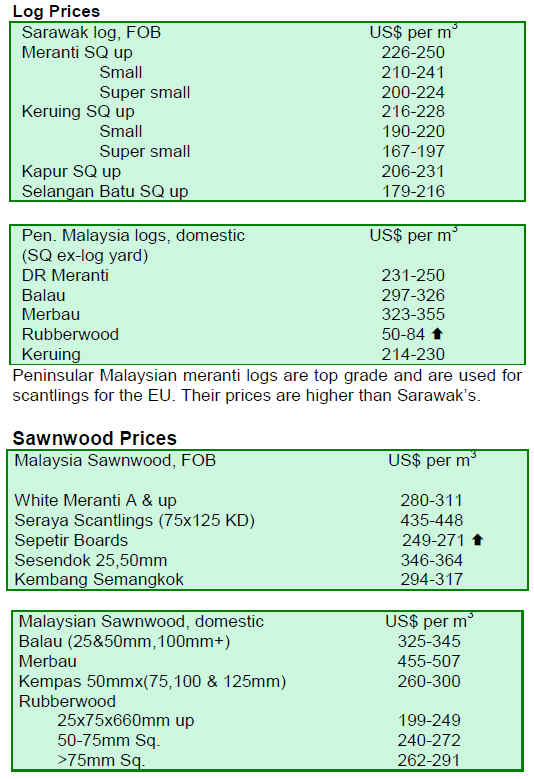
4.
INDONESIA
Furniture forecasts
Exports of furniture from Indonesia are expected to
decline by as much as 18% in 2009, which is down to
US$1.6 billion against US$1.95 billion in 2008. This is
because the European and US economies remain soft says
the Indonesian Furniture Industry and Handicrafts
Association (Asmindo).
Exports for Q1 2009 were down 24% compared to Q1
2008. However, Asmindo is optimistic that the US and
European economies would have bottomed out in 2009.
Considerable efforts have been made by Indonesian
manufacturers to penetrate the Middle-Eastern and Eastern
European markets. However, sales to these new markets
will not be able to make up for the differences as the US
and Western European markets take up to 70% of
Indonesia¡¯s total furniture exports.
Rubberwood prices
While rubberwood prices in Malaysia have been rising, the
same cannot be said of trends in Indonesia.
A series of earthquakes which devastated the city of
Padang in western Sumatra recently also cripple its entire
natural rubber processing and rubberwood product
manufacturing operations.
Sawmills and rubber latex plants belonging to
smallholders disappeared within minutes.
Padang was a major rubber producing city where much of
the country¡¯s rubber latex was produced and exported.
With much of its infrastructure damaged, the prices of
rubberwood have been severely affected. Recovery and
reconstruction is expected to be slow so demand for
rubberwood will be slow to revive and prices will stay
low.
Sustainable forest fund
The secretary general of the Indonesian forestry ministry,
who is also the president of the United Nations Forum on
Forestry (UNFF), is working to establishing a new
sustainable forest fund under the auspice of the UNFF. It
is anticipated that this will be agreed at the eighth UNFF
meeting during the United Nations Economic and Social
Council (Ecosoc)`s session in New York.
Among the number of objectives of the new forest fund is
aid to small island states as well as promoting international
cooperation in financing and adoption of climate change
mitigation activities.
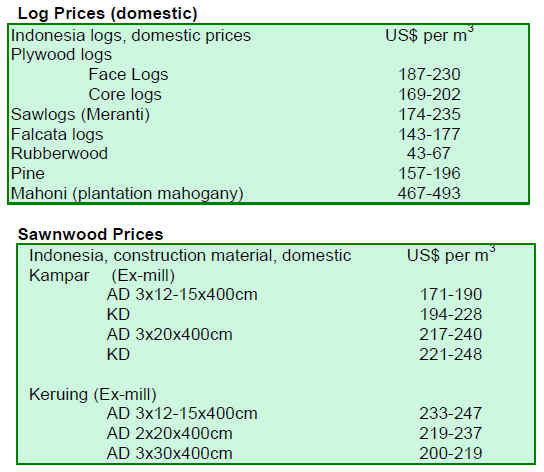
5.
MYANMAR
New grades for Pyinkado
It was learnt that Myanma Timber Enterprise (MTE) has
issued a new price list for Pyinkado (Xylia dolabiformis)
logs. One interesting aspect here is that, up to now, the
grades for Pyinkado were Export Quality and Export
Rejection Quality only.
In the new price list, Pyinkado logs will be classified as:
1st Quality; 2nd Quality; 3rd Quality; 4th Quality, Assorted
Quality and Export Rejection Quality.
These prices became effective for new contracts issued
from 18 September 2009.
Reports indicate that, currently, there are huge outstanding
contracts at the old prices and that it will take sometime to
fulfill these. Once these contracts are satisfied the new
prices will apply. However, as the monsoon season is
over and fresh logs have started to come out, buyers who
have no valid contracts will have to buy them at new
prices. But analysts expect resistance to the new price
structures. For the time being old prices will be still in
effect for most buyers.
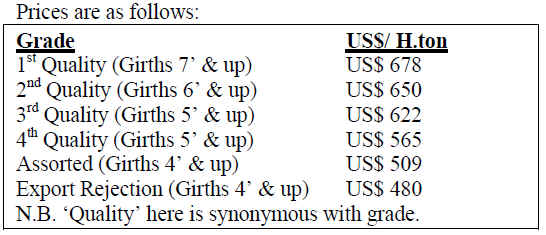
Market conditions
Market conditions remain unchanged from the past
months. While most markets are still struggling, it is only
the Indian market that remains active.
India is one of the largest importers of Pyinkado logs form
Myanmar and log buyers operating in Myanmar are
concerned about the reaction of end-users in India to the
new prices.
As these new prices will take effect only after the old
contracts are exhausted, it may take some months to really
see what the repercussions are.
Myanmar certification
A workshop on timber certification held mid October. It
was reported that the Forestry Minister attended the
opening ceremony and spoke on Criteria and Indicators
(C&I), Chain of Custody (COC) and Sustainable Forest
Management (SFM).
He also talked about establishing a timeframe and
developing a stepwise implementation of the ASEAN
Guidelines on Phased Approach on Timber Certification
by 2015. He stressed the need to have Myanmar timber
certified in order to have maintain access to international
markets.
U Shwe Kyaw, Retired Director General of the Forest
Department (FD), spoke on the progress made on timber
certification in Myanmar. U Zaw Win and U Barber Cho
of the Myanmar Timber Merchants Association (MTA)
spoke on the Demand for Certification in Timber Trade.
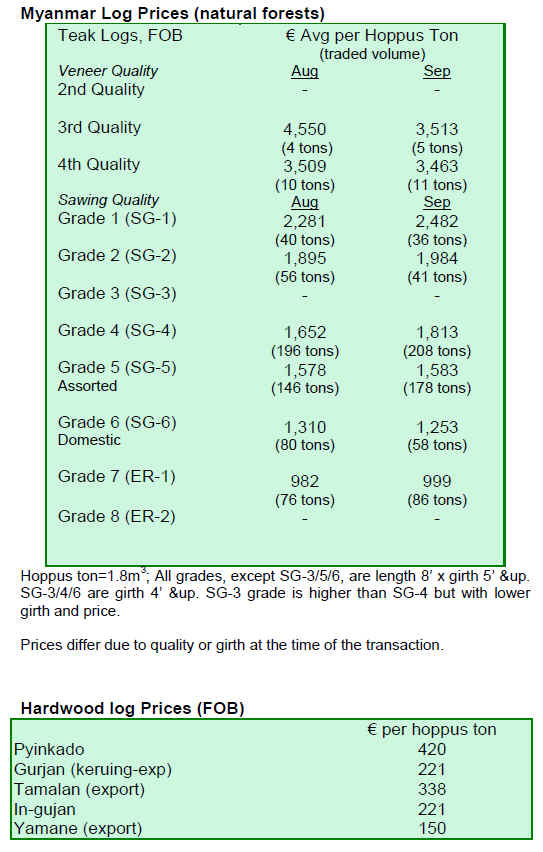
6. INDIA
Economy good
The progress of the Indian economy continues to be good
and the data for July 2009 reports a GDP figure of 6.4 %.
The Indian Planning Commission¡¯s latest assessment for
annual GDP is 6.3% with the inflation rate being
maintained at around 5%.
In the property sector the long running buyers market has
shifted perceptibly towards a seller¡¯s market and this is
reflected in housing starts and timber imports.
Business in the timber sector, especially for sawnwood
and wood based panel products, has been brisk. There are
reports of considerable increases in demand for PF bonded
film faced plywood and doors and frames.
Analysts say the market for machine made doors and
frames is steaming ahead with a growth rate of about 15%
per annum and this is driving the re-tooling of old
factories.
The tail-end of the departing south west monsoon has
caused floods at some places but overall it has proved a
boon in most of the areas, helping the crops which in turn
will lift consumer spending and support demand for wood
for building and allied uses in rural India.
Rising prices for plantation wood
The industry has voiced concern over the rising prices for
plantation grown eucalyptus, acacia mangium and poplar.
The price increases are tempting more industries to think
in terms of importing competitive raw materials for
peeling for core veneer for plywood.
American hardwoods are being aggressively promoted in
India and the promotion is working. Poplar is gaining
market share.
Imports of core veneer logs will ease the production cost
especially for those factories close to the ports more so
than for factories inland, for example in Uttaranchal and
Haryana, which face high haulage costs.
Some people are saying the Indian Plant Quarantine
department needs to re-examine the current regulations
and remove restrictions on imported species. This they say
is required as imports augment domestic raw material
supplies and benefit employment, the environment and the
economy in general. The Association of Industries has
been called upon to take the initiative for this.
Expand the resources base
To expand the resource base the timber industry is
lobbying for a change of use for the so-called ¡®Cultivable
Non forest Areas¡¯ and degraded forest lands. These, it
says, should be allocated for plantations of fast growing
species.
There is great scope in this field as it would open more
land to industrial companies, help carbon absorption to
earn carbon credits, generate a sustainable raw material
base and aid rural employment.
The industry says the time has come for Government to
help existing industries to establish plantations which will
provide a sustainable raw material base and encourage
new investors into the sector. The minister in charge of
forests and the environment, Mr.Jairam Ramesh, has been
asked to support this idea for expanding the plantations.
Teak trade
On the trade front, the flow of teak and other hardwood
logs was satisfactory in the period under review. The
exports performance for wood products was also good.
With less Teak coming in from Myanmar and Thailand
demand is strong and rising.
The volumes of teak imported from sources other than
Myanmar are below the levels a few months ago and this
is causing the market to firm.
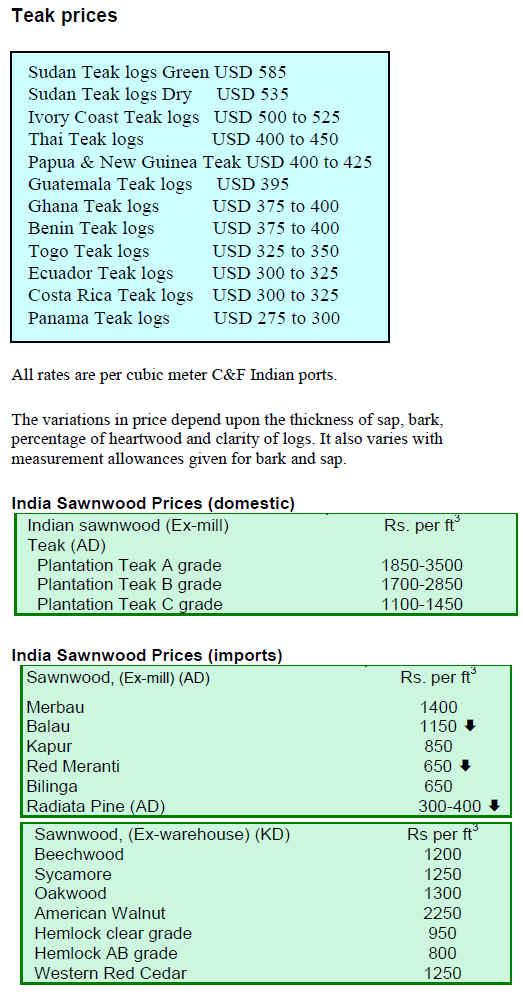
7. BRAZIL
Brazilian currency appreciation pain
The wood-processing industries have faced difficulties
over the past few years due to the fall in exports and the
appreciation of the Brazilian Real against the US dollar.
Brazilian exports from January to August of last year
totaled US$1.998 billion down 46% on the same period of
2009.
In the state of Paran¨¢, exports fell from US$632 million to
US$343 million in the first eight months of 2009,
compared to the same period of last year.
In an effort to address the problem of falling exports,
entrepreneurs in the timber sector recently suggested to the
Federation of Industries of Paran¨¢ (FIEP), the creation of a
financing programme for wooden housing, more
integration of the sector, higher investment in technology
and innovation and reduction of the tax burden on
industries in the sector.
According to the Brazilian Association of Mechanically-
Processed Timber Industry (ABIMCI), the first signs of
recovery in sales were registered in August.
The sector expects that sales will stop falling at the end of
the vacation period in Europe, citing the experience that
the second half of the year is usually better than the first.
But other exporting countries are beginning to think this is
a vain hope.
Fall in exports
Alta Floresta, in the West-Central state of Mato Grosso,
exported 20% less wood products between January to
August 2009, compared to the same period of last year.
Wood is the main export from the state. In August 2009,
exports of non-coniferous (tropical) products were around
US$6.7 million. Exports of other products including
blocks, laminated items and mouldings were around
US$305,200. Sawnwood exports totaled some
US$254,600.
The largest export market was the United States
accounting for US$3.9 million, followed by Canada at
US$1.3 million, Spain US$592,000, India US$305,000
and Israel with US$282,300.
Mandatory wood identification
A new House of Representatives bill (No. 5362/09) makes
mandatory the identification of species logged. The
measure will be obligatory to facilitate chain of custody
from harvesting, transportation to commercialization.
The draft bill establishes that the identification will be
carried out using a scientifically-reliable technique. As
such, a certificate issued by the supplier of the raw
material or for the traded product will not be sufficient to
prove the product origin.
Although in Brazil wood is sold with ¡®green seals¡¯ and
¡®certificate of origin¡¯, many high-value endangered tree
species are still being harvested and sold without
appropriate documents issued by the Brazilian Institute of
Environment and Natural Resources (IBAMA) or state
control agencies.
DNA reader
The new draft bill does not specify the technique to be
used in the timber identification. However, the technology
to identify DNA has been developed in Canada and has
been already used in some countries for food safety etc.
DNA bar coding is said to be a fast and inexpensive tool to
identify species of flora and fauna. The expectation is that
inspectors in Brazil will have wireless DNA reader to
identify species on the spot.
Brazilian agenda in Copenhagen
¡®Reducing Emissions from Deforestation and Forest
Degradation¡¯ (REDD) has gained importance on the COP-
15 agenda to be discussed later this year in Copenhagen,
when the mechanisms for combating climate change after
2012 are expected to be defined.
In the second week of September, the Brazilian President
met with the Brazilian Task Force on REDD and Climate
Change, formed by governors of the nine Brazilian
Amazonian states. It was agreed that forests will be part of
the Brazilian agenda in Copenhagen.
There are some basic concerns on the finance mechanisms
for REDD. The major concern of Brazil is whether this
funding should be public or private, or a mixture of both.
Brazil has projects that illustrate the feasibility of two
types of arrangements, without being mutually exclusive.
These are the Amazon Fund, administered by the National
Bank for Economic and Social Development (BNDES).
This operates from donations (so far it received a
contribution of BRL 215 million from the Norwegian
Government). The other project is conducted under the
Sustainable Amazon Foundation. The later administers
public and private resources in a project with indigenous
people in protected areas of the state of Amazonas.
The scope of the projects, either nationally or subnationally,
is directly related to companies¡¯ interest to
contribute funds for REDD programmes.
The Conservation and Sustainable Development of
Amazonia (IDESAM) institute estimates that combating
deforestation would require about US$15 billion per year.
The driver of deforestation is the market demand for
products deforestation generates. IDESAM suggests there
is a need to strengthen the dynamics of an economy based
on forest products from biome preservation.
Within this framework companies will have an interest in
participating when clearly identify values are identified
taking into account environmental, social and economic
benefits.
REDD, it is claimed, is a window of opportunity for Brazil
and other countries in the region. However, there is a
consensus that there are risks also.
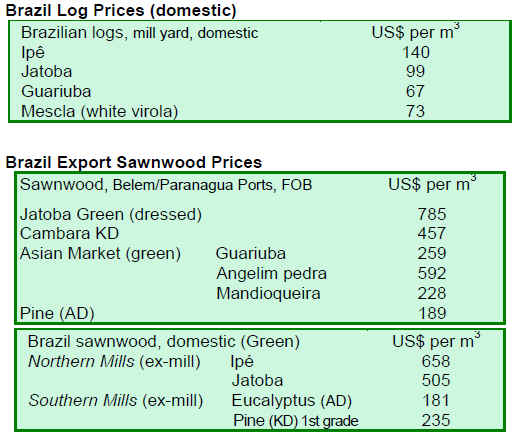
8.
PERU
Exports to grow in 2010
The forestry and timber sector is probably the main
economic activity in the Peruvian rainforest and this sector
has not been immune to the effects of the international
financial crisis. However, the manager of Husqvarna in
Peru has aid that the effects of the global recession are
already being overcome and that he is optimistic for 2010
wood product exports which could grow by about 30%
from 2009 levels.
By way of example it is reported that economies such as in
Loreto, which depends on wood products, has seen a 70%
fall in exports from January to July 2009 compared to the
same period a year ago.
In Ucayali, the drop was around 50% and in San Martin
the decline is estimated at around 30%. Nationally
between January and July 2009 exports of wood products
were down about 55%.
In 2009 domestic demand held up better and the domestic
demand forecasts for 2010 are positive as there are good
prospects in the construction sector which will revive as
the global situation eases.
Peru to reduce clearing for agriculture
Over the next 10 years it has been proposed that the
clearing of Amazonian forests (currently at around
150,000 hectares annually) will be reduced to zero. This
proposal has been attributed to the Minister of the
Environment, Antonio Brack.
Harmonising environmental management
According to the Director of Policies of the Department of
the Environment, environmental impact assessment is to
be introduced for public and private sector developments
in a wide range of sectors.
The regulations on EIA are to be applied to agricultural
and forestry activities as well as to other industrial and
commercial sectors.
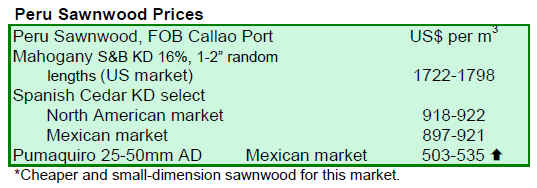
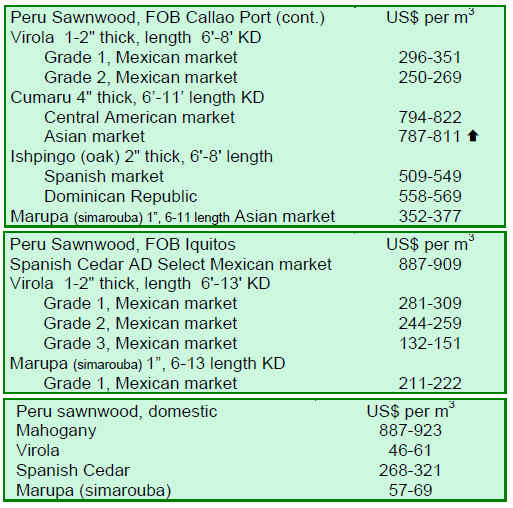
9. BOLIVIA

10. MEXICO
ProTree programme
The National Forestry Agency (Conafor) began a revision
and improvement process which includes refinement of
the ProTree programme, said its director, Jose Manuel
Torres.
The ProTree programme review will be done focusing
resources on strategic areas, encouraging the preservation
activities, restoration and productivity as well as a
concentration on institutional issues.
The new CEO of the National Forestry Agency said that
special emphasis will be on monitoring the application of
human, material and economic resources.
He also emphasized that there is a strong government
commitment to support the development of forest areas
especially those with huge marginal areas.
ProTree applies resources generating opportunities for
owners and holders of forest land, promoting community
development and strengthening supply chains without
neglecting conservation and restoration.
Mexico to host climate change conference
Mexico will host the XVI Conference of the Parties on the
Framework Convention of the United Nations against
Climate Change next year.
At the closing of the eighth XXI Century Mexico Forestry
Expo, the President said the effort that Mexicans do for the
environment is recognized worldwide today. The
establishment of forest plantations has been promoted for
the production of pulp and paper and the furniture
manufacturing.
11.
Guyana
Market Trends
Greenheart and Mora logs prices remained fairly stable in
the period under review while prices for Purpleheart logs
(standard sawmill and fair sawmill qualities) experienced a
decline for the period.
Compared to the previous period reported, prices for rough
sawn Greenheart lumber have fallen for both prime and
select categories. Mora sawnwood prices have remained
relatively stable.
Dressed Greenheart, standard quality has enjoyed
favourable prices (USD 1165/959 per cu.m) for the period.
On the other hand, Baromalli plywood has recorded a
small drop in price for both the BB/CC and utility
category.
Prices for roundwood (which includes piles, post and
charcoal) have been in positive territory.
Growth in exports of value added products and non timber
products was significant with doors and wooden utensils
being major contributors, followed by other categories
which includes mouldings, spindles, indoor and outdoor
furniture.
Guyana Expo
Under the theme ¡°Promoting Business in a Low Carbon
Environment¡± the national trade show in Guyana held on
October 1st - 6th 2009, dubbed ¡®GUYEXPO¡¯ saw strong
support from investors and manufacturers locally,
regionally and internationally. This event was held at the
National Exhibition Centre in Sophia, Guyana.
According to the Guyana Office for Investment, the
organization acting as the primary contact for investors
and exporters, Guyana is unique and there are a number of
investment opportunities available. These include
Guyana¡¯s strategic geographical location on the northeast
coast of South America outside the hurricane zone, with
preferential access to American and European Union
markets.
Agrifest Guyana
The Ministry of Agriculture, through the Guyana
Marketing Corporation, will be hosting another significant
event, Agifest, as part of the ¡®Agricultural Month¡¯
activities. This is the inaugural Agrifest, Guyana¡¯s leading
Agriculture Trade and Investment Festival. Agrifest 2009,
a one-day trade and investment festival to be held on 31st
October at the National Stadium in Guyana, will culminate
the Agriculture Month activities.

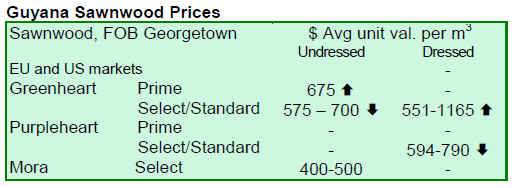
|